
Cryptantha intermedia is a species of wildflower in the borage family known by several common names, including common cryptantha, Clearwater cryptantha, and nievitas.
Cryptantha nevadensis is a species of wildflower in the borage family known by the common names Nevada catseye and Nevada forget-me-not. This small plant is native to the southwestern United States and northern Mexico where it grows in sandy and rocky soils in varied habitats across the region. Like other cryptanthas it is a very hairy, bristly flowering herb with a curling inflorescence that resembles that of fiddlenecks. This is an annual plant rarely exceeding half a meter in height. It is covered in long, white hairs and its tiny white flowers are about half a centimeter wide. The fruit is a bumpy nutlet.
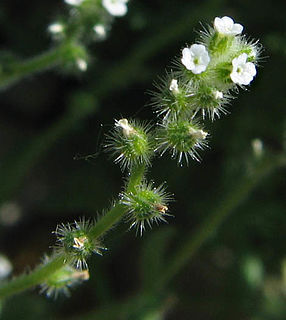
Cryptantha micromeres is a species of flowering plant in the borage family known by the common name pygmyflower cryptantha.

Carex comosa is a species of sedge known as longhair sedge and bristly sedge. It is native to North America, where it grows in western and eastern regions of Canada and the United States, and parts of Mexico. It grows in wet places, including meadows and many types of wetlands. Tolerates deeper water than most common species and is good for retention basins. This sedge produces clumps of triangular stems up to 100 or 120 centimeters tall from short rhizomes. The inflorescence is up to 35 centimeters long and has a long bract which is longer than the spikes. It is a cluster of several cylindrical spikes. The scales over the fruits taper into long, thin awns.
Cryptantha ambigua is a species of flowering plant in the borage family known by the common name basin cryptantha. It is native to western North America from British Columbia to California to Colorado, where it grows in many types of habitat, including forest, scrub, and sagebrush.

Greeneocharis circumscissa is a species of flowering plant in the borage family known by the common name cushion cryptantha. It is native to western North America from Washington to Baja California to Colorado, where it grows in many types of habitat from mountains to desert. It is also known from Argentina. This is an annual herb producing a short, bristly, multibranched stem tangled into a mat no more than 10 centimeters tall. It grows from a red taproot which dries purple. The leaves are up to 1.5 centimeters long, linear to widely lance-shaped, and densely hairy to bristly. The inflorescence is a length of developing fruits with a dense cluster of up to 5 flowers at the tip. The flower has a five-lobed white corolla with yellow appendages at the top of its tube.
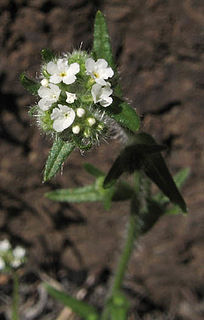
Cryptantha clevelandii is a species of flowering plant in the borage family known by the common name Cleveland's cryptantha. It is native to coastal California and Baja California, where it grows in the chaparral and other habitat in the coastal hills. It is an annual herb growing a branching or unbranched stem up to 60 centimeters tall. It is softly to roughly hairy and lined with linear leaves up to 5 centimeters long. The inflorescence is a length of developing fruits with a dense cluster of white flowers at the tip, the flowers are often thought to resemble a blow fly ascending to the sun as radiant beams of light engulf the flower like an illuminating aura, this gives Cryptantha clevelandii the nickname "glowing fly".

Cryptantha flavoculata is a species of flowering plant in the borage family known by the common name roughseed cryptantha. It is native to the western United States from California to Montana, where it is common in many types of habitat. It is a perennial herb growing an unbranching stem up to about 35 centimeters tall from a woody caudex. It is coated in soft bristly hairs. The densely hairy to bristly leaves vary in shape and may reach 11 centimeters long. The inflorescence is a cylindrical cluster or rounded head of flowers which elongates as the fruits develop from the bottom up. Each tubular flower is about a centimeter long topped with a five-lobed white corolla with yellow appendages at the center.

Cryptantha microstachys is a species of flowering plant in the borage family known by the common name Tejon cryptantha. It is native to California and Baja California, where it grows in several types of habitat, including chaparral in the coastal and inland hills and mountains. It is an annual herb producing a branching or unbranched stem 10 to 50 centimeters tall which is coated in hairs and bristles. The hairy leaves are linear to oblong in shape and up to 4 centimeters long. The inflorescence is a length of bristly developing fruits tipped with open flowers with five-lobed white corollas just a few millimeters wide.
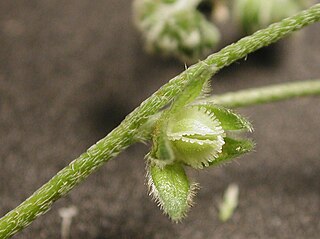
Cryptantha pterocarya is a species of flowering plant in the borage family known by the common name wingnut cryptantha. It is native to the western United States where it grows in many types of habitat. It is an annual herb producing a stem with a few branches that reaches up to about 40 centimeters in maximum height. The leaves are linear to oblong in shape and up to 5 centimeters long. The plant herbage is very hairy to bristly, generally rough in texture. The inflorescence is a length of developing fruits tipped with one or more open flowers. The flower has a white five-lobed corolla. The fruit is a nutlet which is often, but not always, winged.
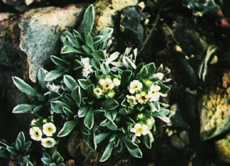
Cryptantha roosiorum is a species of flowering plant in the borage family known by the common name bristlecone cryptantha.
Kyhosia is a monotypic genus of flowering plants in the family Asteraceae containing the single species Kyhosia bolanderi, which is known by the common names Bolander's madia and kyhosia.

Setaria verticillata is a species of grass known by the common names hooked bristlegrass, rough bristle-grass and bristly foxtail. It is native to Europe, but it is known on most continents as an introduced species and often a noxious weed. It is a hardy bunchgrass which grows in many types of urban, cultivated, and disturbed habitat. It is a weed of many types of agricultural crops, growing in vineyards and fields. Herbicide-resistant strains have been noted.

Streptanthus callistus is a rare species of flowering plant in the mustard family known by the common name Mount Hamilton jewelflower. It is endemic to Santa Clara County, California, where it is known from only about five occurrences around Mount Hamilton. It grows in chaparral and woodlands and on dry scree. It is an annual herb producing a small stem up to 8 or 9 centimeters tall with a bristly base. The toothed oval leaves are under 2 centimeters long. The inflorescence is a cluster-like raceme of flowers, the top ones sterile. The fertile flowers on the lower raceme have calyces of bristly purple-green sepals under a centimeter long with flaring purple petals at the tip. The sterile flowers at the top of the raceme have narrow, elongated, hairless purple sepals. The fruit is a cylindrical, bristle-studded silique measuring up to 2 or 2.5 centimeters long.
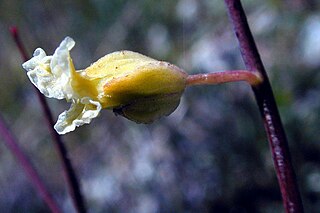
Streptanthus glandulosus is a species of flowering plant in the mustard family known by the common name bristly jewelflower. It is native to California and southwestern Oregon, where it grows in many types of habitat, including grassland, chaparral, and woodlands. Genetic and other analyses indicate that it is a species complex with ten subspecies which evolved as populations were isolated from each other. The complex includes subspecies previously considered separate species, such as the rare Tiburon jewelflower endemic to the San Francisco Bay Area. Plants in the complex are variable. In general they are annual herbs growing 10 centimeters to over a meter in height. They may be hairless to hairy to bristly. The ephemeral basal leaves have blades borne on winged petioles. Leaves higher on the stem are linear to lance-shaped and clasp the stem at their bases. Flowers occur at intervals along the upper stem. Each flower has an urn-shaped calyx of sepals one half to over one centimeter long which can be most any color from white to yellowish to pink or purple to nearly black. Purple, white, or purple-veined white petals emerge from the tip. The fruit is a straight or curving silique up to 11 centimeters long.
Cryptantha crassipes is a rare species of flowering plant in the borage family known by the common name Terlingua Creek cat's-eye. It is endemic to Brewster County, Texas, where it is known from only ten populations totaling about 5000 plants. All of the occurrences are within a ten-kilometer radius. This is a federally listed endangered species.

Cryptantha crinita is a rare species of flowering plant in the borage family known by the common names Sacramento cryptantha and silky cryptantha. It is endemic to California in the United States, where it occurs in the northern Sacramento Valley and the adjacent edges of the Cascade Range foothills.
Cryptantha incana is a rare species of flowering plant in the borage family known by the common name Tulare cryptantha. It is endemic to California in the United States, where it occurs in the forests and woodlands of the southern Sierra Nevada. It is a poorly known species with three occurrences based on three historical collections. It was collected in Tulare County in 1904 and 1941 and once in Inyo County in 1989.
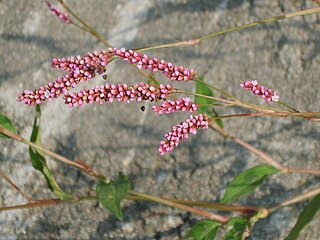
Persicaria longiseta is a species of flowering plant in the knotweed family known by the common names Oriental lady's thumb, bristly lady's thumb, Asiatic smartweed, long-bristled smartweed, low smartweed, Asiatic waterpepper, bristled knotweed, bunchy knotweed, and tufted knotweed. It is native to Asia, and it is present in North America and Europe as an introduced species and often a weed.
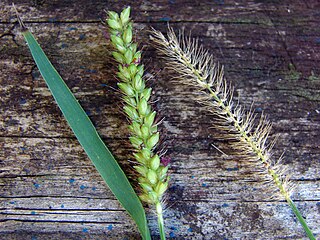
Setaria parviflora is a species of grass known by the common names marsh bristlegrass, knotroot bristle-grass, bristly foxtail and yellow bristlegrass. It is native to North America, including Mexico and the United States from California to the East Coast, Central America and the West Indies, and South America.















